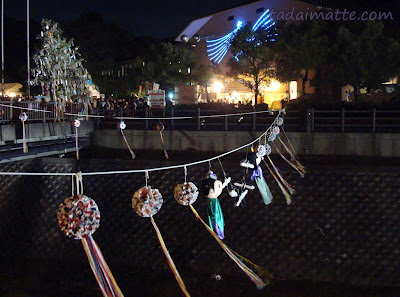 |
| Tanabata lanterns in Katano City, Osaka |
One of the exciting things about living in another country is discovering its holidays. I don't necessarily mean all holidays, as it's tough to get too into, say, Louis Riel Day. Still, Japan offers a good number of cultural and religious holidays that can be a lot of fun for newcomers to celebrate. You may not believe in oni, but there's something gratifying about throwing around beans and eating 7-ingredient sushi on February 3. Even better is that fact that holidays really are a huge deal in Japan - commercialization is a threat just like here in the west, but the attention that holidays like Girls' Day and Setsubun get helps make them accessible to visitors.
My personal favourite Japanese holiday is July 7, Tanabata.
 |
| Orihime and Hikoboshi, the weaver and the herder |
Tanabata (七夕, meaning "Evening of the seventh") is a Japanese star festival, originating from the Chinese Qixi Festival. It celebrates the meeting of the deities Orihime and Hikoboshi (represented by the stars Vega and Altair respectively). According to legend, the Milky Way separates these lovers, and they are allowed to meet only once a year on the seventh day of the seventh lunar month of the lunisolar calendar.
Katano City in northeast Osaka was said to be quite famous in the prefecture for its Tanabata celebrations, so I attended every year. Originally, Marisa and I thought this was a perfect opportunity to buy and get suited up in yukata, the traditional summer kimono, and attend a real festival. Katano's festival features 14,000 candles laid out in intricate patterns. One of my students was a resident of Katano and on the planning committee, and she spent many long hours helping to organize the festival.
Besides the main attraction, the lights, the festival also featured a small collection of stalls along the walking path, with the usual festival food, shaved ice, chocolate bananas, goldfish-scooping and other games. There was a stamp rally at one point, and more star-themed food than you can imagine. That first year, we brought home a bagful of festival goldfish that died within a week. The gentleman at the stall gave us way more than we needed after we utterly failed at catching even a single goldfish on our own.
 |
| Katano's beautiful candlelights |
Besides the main attraction, the lights, the festival also featured a small collection of stalls along the walking path, with the usual festival food, shaved ice, chocolate bananas, goldfish-scooping and other games. There was a stamp rally at one point, and more star-themed food than you can imagine. That first year, we brought home a bagful of festival goldfish that died within a week. The gentleman at the stall gave us way more than we needed after we utterly failed at catching even a single goldfish on our own.
Keihan Railways, as one of two train lines servicing Katano City, heavily promotes the city's Tanabata festival and likely brings in most of the festivalgoers coming from out of town. Two of the commuter trains on the Keihan Main Line/Katano Line are named Hikoboshi and Orihime, after the deities, and they come to and from Katano and Osaka City in the morning (Orihime) and evening (Hikoboshi), never meeting. On July 7th, however, both trains are docked in Kisaichi Station, finally in the same place at the same time. It's one of the local events Keihan sponsors, and no surprise that they'd want to capitalize on the popular "romantic" holiday - every year, the Katano Line is packed with festival-goers in yukata on their way to and from Kisaichi Station.
 |
| Yukata on the Katano Line |
Another year, I went with my co-worker S, her young daughter, and her friend Katsue. This was a lot of fun as Katsue knew a lot about the culture of the holiday, and I had a few wishes I wanted to make, so the four of us tied up our wishes written on tanzaku in the trees.
 |
| These decorations, including Orihime and Hikoboshi, hung over the river in Katano |
We ate star-shaped okonomiyaki and S's daughter had her photo taken with people dressed up as Orihime and Hikoboshi. The city was really shining that year, even though it had rained in the morning, with so many beautiful candlelit designs on the riverbanks. My Japanese friends also designed our own tanzaku, but lacking any trees near my low-rise apartment, I hung it up on my balcony...shhh!
 |
| Tanabata wishes written on tanzaku |
The rain petered out in the late afternoon, however, so we thought the festivities might go ahead as they had the year before, but there just hadn't been enough time. When we got to Katano, the decorations were up but the festival absent. We settled for dinner in our yukata at Ganko Sanjo in Kyoto, but it wasn't the same as my regular Tanabata festival.
This year, I'll be writing out a wish again, though my yukata will probably stay in the closet until the JCCC's natsumaturi next Saturday. So, what are you wishing for? Take a little time to think about it tomorrow!